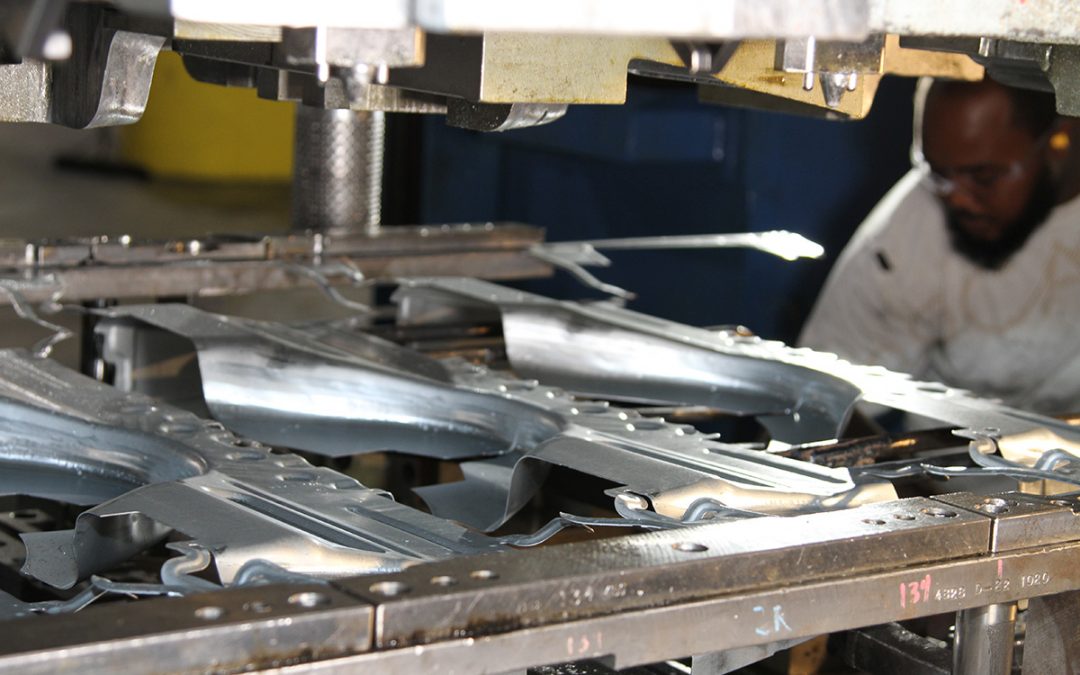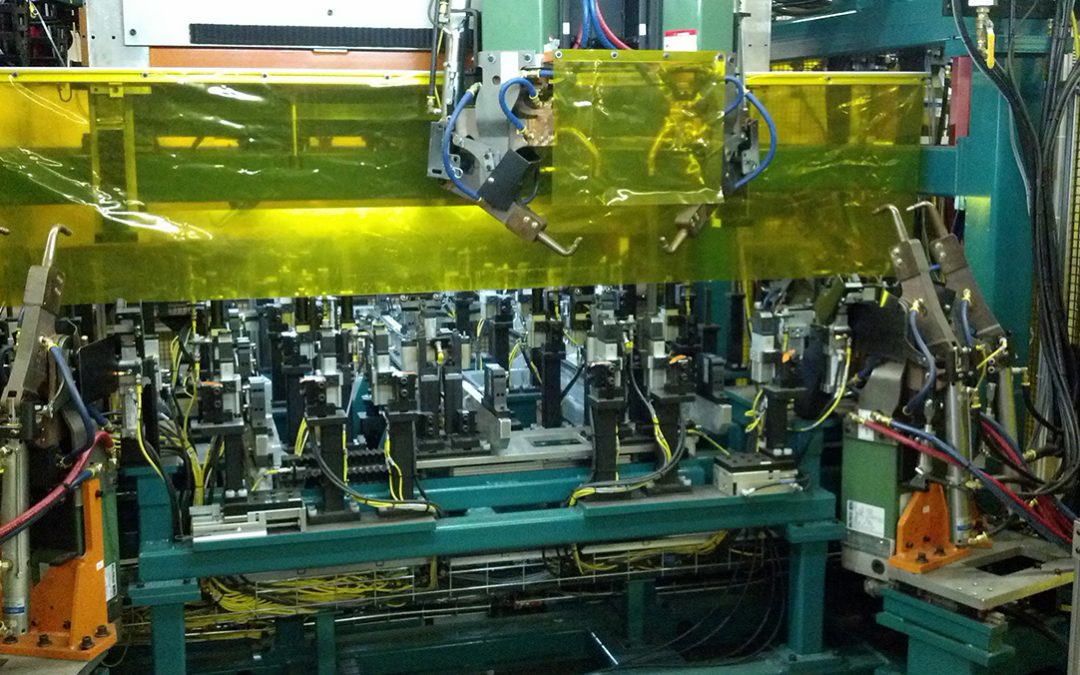
by admin | Jun 20, 2018 | LTC Roll Blog
In the world of manufacturing, there are various ways to produce and assemble products. One of those production methods is metal stamping. There are many benefits to metal stamping that make it attractive to manufacturers, however not all utilize it in-house. Here at LTC Roll and Engineering, we utilize metal stamping in-house. With our clients in mind, we work to produce the best possible products for them, and stamping helps us do that. We believe three key benefits make it beneficial for our clients and us. Reduces Handling Where other roll form manufacturers have to send pieces and components out of their facility for forming, we possess the stamping capability in-house. This allows us to form components efficiently while reducing how many people handle the components. Other manufacturers have to think about transporting components to and from their facility, as well as whether or not the other facility has their same standards. Stamping in-house means we have full control over the process with fewer hands involved to make a mistake. Increases Efficiency We are able to move a component through production with no stopping or wait time. We can stamp bulkheads, brackets and similar parts, and then move them to welding and the assembly floor, all in-house. This cuts down on the overall production time for products. Everything is done at one location and from a single source. There is no waiting for another facility to complete their part of the puzzle. Once we produce a line of components, we can immediately move them to the next process. Minimizes Cost Metal stamping reduces production costs in a few different...

by admin | Jun 6, 2018 | LTC Roll Blog
Over the last century or so factories and manufacturing have staked their claim in our ever growing and inventing culture. As mass production became more and more common, the industry demonstrated its benefits. Now, it is far more common to buy something manufactured in large numbers as opposed to a unique item. Our culture and way of life have become dependent on mass production. This is not a bad thing. Here are three reasons why we need manufacturing that benefit more than the production of new items. Jobs The Bureau of Labor released a report stating that the manufacturing industry employed over 12 million U.S. citizens in 2016. That is a substantial number of our neighbors that are involved in this industry in some manner. If those jobs were to go away, we would be faced with millions of families not having enough money to eat or support themselves. Luckily, the constant demand for manufactured goods ensures the support of those families. It is an industry that constantly has jobs available and upward motion. Production There are no faster means of producing the number of goods our country demands than through mass manufacturing and production. Whether it is our automobile demand or our demand for phones, there is no other way to keep up with demand. Likewise, every year the industry releases new models and items for production. The constant cycling through of products has improved the speed of manufacturing for these items. We are a consumer culture and manufacturing answers our need for fast turnover. Innovation As a culture, we are fascinated by the new, innovative, and undreamed. What we...

by admin | May 23, 2018 | LTC Roll Blog
Many assume that because manufacturing is an older industry that focuses on building bigger pieces, that it also lacks a sense of finesse. However, there is more to manufacturing than just slapping together large pieces of metal. A great deal of thought, process, and design go into manufacturing. Moreover, an important stage of that process is prototyping. Prototyping involves a lot more than simply making a sample of a product. There are important reasons why prototyping happens before a design goes into production. Let’s look closely at why prototyping is so crucial to the manufacturing process. Proof Designs A design will never be perfect the first time through, and so the proofing process is needed. A prototype can be looked over and evaluated to get a better understanding of the specific design. At this stage, you can tweak things and alter the design to optimize it. Just as you would look at a spreadsheet or press release before sending it out, creating a prototype of your design is the last look over. Once the design meets both parties’ approval, the design can go into production with the security that it is optimized. Identify Defects Whether a client or the manufacturing company come up with the design, there could be unforeseeable problems on the page. By producing a prototype, both parties can visualize the final product. If there are any defects or potential problems, you can correct them before final production begins. Evaluation at this stage is critical to producing the highest quality finished product. It is also easier to find issues when you have a physical copy of what...

by admin | May 9, 2018 | LTC Roll Blog
The art of welding plays a significant role in the manufacturing industry. Unfortunately, many people overlook this vital element when considering the functions of manufacturing. It often takes great skill and expertise in order to craft and fuse pieces of metal together in a way that strengthens the final product. Moreover, it takes incredible focus and practice to perfect this skill. Once a piece is fused correctly it enhances every aspect of the overall product greatly. Surprisingly, welding takes on many forms, and each is unique in its own way. At LTC Roll and Engineering, our associates utilize various types of welding techniques to provide quality to products to all of our clients. Laser Welding Associates at LTC Roll and Engineering typically use laser welding when building tubular products. This technique is most useful when pieces need low frequency and less penetration than provided by other processes. Because we most often utilize laser welding with our tubular products, we have made our equipment extremely adaptable. Using laser welding in-line our roll forming machines brings great cost and time savings to our customers. We’re one of very few roll forming companies with this capability. Our equipment has the ability to weld a variety of tube configurations and material types. Welding tube configurations include square, round, custom shapes, and five-sided. The adaptability of our laser welding ensures that each piece receives quality welding. Induction Welding For heavy gauge and high strength production, inline induction welding is usually the answer. Because of the deeply penetrative nature of induction welding, it is best suited to weight bearing components. We also utilize induction for...

by admin | Apr 25, 2018 | LTC Roll Blog
There are many different ways to manipulate metal into the shape that you wish, called metal forming. Here at LTC Roll and Engineering, we use four types of metal forming to accommodate our clients’ needs. Here are the four methods we use and how they can be useful. Roll Forming Roll forming creates the cylinder-shaped metal pieces used to build automobiles. We have over sixty coil-fed roll form lines between all of our plants. As a result, this allows us to make orders of identical pieces to our client’s specifications. Over the years our team has pioneered the tools that are used to create stronger and lighter metal pieces. Through roll forming, we have been awarded “Supplier of Excellence” by General Motors. Laser Cutting Our five-axis laser cutting creates three-dimensional prototypes. Clearly, laser cutting is a great way to test a design out before sending it to production. We focus on fabricating parts that perfectly fit our client’s needs. Specifically, the process of prototyping is an integral part of providing client’s high-value products. However, traditional tooling and metal forming methods alone would not be able to achieve the result we can get by laser cutting. Therefore, we also utilize laser cutting on its own to produce products for clients. It is a priceless tool in the metal forming business. Stamping Undoubtedly, stamped metal components increase the durability of final products in all types of vehicles. For this reason, we stamp bulkheads, brackets, and similar parts. Over the years, our stamping capability has grown and put us on the front line of auto part production. Currently, we have over forty-five stamping...

by admin | Apr 11, 2018 | LTC Roll Blog
Rocker panels may not be a household name, but they are an important part of your car. Thanks to manufacturing, rocker panels can be produced at a pace that keeps up with our car manufacturing demands. How cars are built and assembled is not something we talk about at great length. However, we use them every day to get from point A to point B, and then back again. We can take these amazingly helpful machines for granted. Rocker panels are just one piece of a car puzzle, but without them, a car wouldn’t be a car. Because they are so vital to our daily lives, we make it a point to produce a high-quality manufactured product. What are Rocker Panels Rocker panels are stamped pieces of strong metal that form part of the structural body of the car. They are an integral part that runs along the side of your car between the front and rear wheel wells. Other than the roof supports, they are the only part of the structural body that connects the front and the back of your car. In other words, rocker panels keep the back of your car from separating from the front of your car. When you think of a piece of metal that you step over every time you get into your car like that it’s easy to see how we take these machines for granted. LTC Method LTC Roll and Engineering have a special process to create innovative new rocker panels. We have worked with leaders in OEM, engineering, and metallurgy to make them lighter, stronger, and more durable. This...











